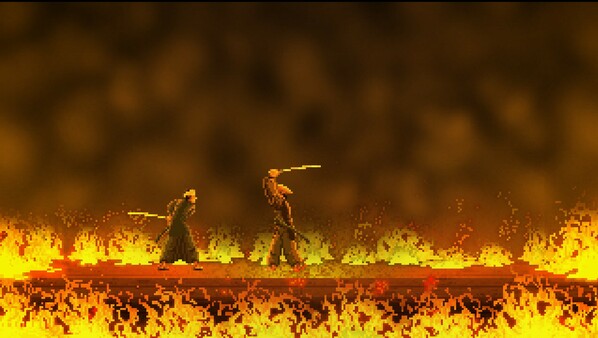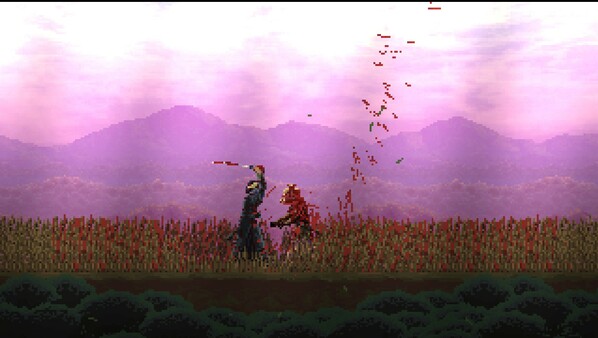Overall: 8/10 Story: First Cut: Samurai Duel doesn’t aim to deliver a deeply engaging narrative, but it does offer a serviceable campaign scenario that sets the stage for its gameplay-focused experience. The campaign consists of 8 levels, most of which include multiple acts, providing a structured progression through increasingly challenging scenarios. Additionally, each stage shows you your overall mission score + time, individual chapter's mission score + time, and provides you with a letter rank based off your performance. While the story isn’t the centerpiece, the campaign does its job well for an arcade-style game, giving you just enough context to keep you invested as you move from one fight to the next. Beyond the campaign, the game shines with its four distinct game modes: - Duel: Classic 1v1 battles. - Survival: Fight wave after wave of enemies, with the option to enable an AI companion to fight alongside you until you both fall. - Ring Out: A 1v1 match where you aim to reach a target score first by killing your opponent repeatedly. - Last Man Standing: A chaotic mode where you take on up to 8 enemies, aiming to be the sole survivor. On top of this, each mode also offers extensive customization options. You can tweak the difficulty, set the score-to-win, and select from various stages and backgrounds, among other adjustments. This flexibility allows for a highly personalized experience, keeping the gameplay fresh and engaging. While this is clearly not a narrative-driven game, I feel like the campaign scenario works well within the arcade framework, and provides enough structure to tie the levels together. However, it’s the variety of game modes and the deep customization options that truly stand out, offering a rich, replayable experience that more than makes up for the lack of a traditional storyline. Gameplay: First Cut delivers an arcade-style gameplay experience that feels laser-focused on its core mechanic: fast, high-stakes sword combat. At its heart, this is a game about precision and timing, and its tagline could easily be "easy to understand, difficult to master." Despite its simple premise, the gameplay achieves a satisfying depth and complexity that makes every duel both thrilling and punishing. For starters, the title "First Cut" isn't just a name; it’s a warning. Quite literally, one cut is all it takes to kill, whether you're slicing through an NPC or falling victim to the blade yourself. This brutal efficiency defines the game’s tight and satisfying combat loop, where there’s absolutely no room for error. Next, the combat revolves around three key mechanics of blocks, strikes, and pushes. Blocks and strikes depend on a high, mid, or low angle, while pushes add a layer of unpredictability, allowing you to create distance between yourself and enemies. Blocking is intuitive; hold your sword at the height of an incoming attack or perfectly time a swing to counter it, but that simplicity belies just how sharp your timing needs to be. There’s also an interesting risk-reward element baked into the core mechanics. You can charge a swing ahead of time for extra reach, but doing so leaves you vulnerable, as you can’t block during the charge-up. This forces you to weigh every decision carefully, rewarding boldness but punishing recklessness. Additionally, the in-game tutorial is actually very concise and teaches you almost everything you need to know about the basic mechanics. From there, it’s all about clean execution and perfect timing; However, the tutorial barely scratches the surface of the deeper strategies waiting to be uncovered. It doesn't take long for enemies to start attacking you from all sides, and suddenly the game becomes about much more than swordplay. You’re suddenly met with gameplay elements of crowd control, threat management, and deciding when and where to engage, adding layers of strategic depth that make each encounter unique. Lastly, one of the most satisfying (and grisly) mechanics is your ability to weaponize blood. The blood accumulated on your sword can be slashed toward enemies, blinding them temporarily and giving you a critical edge. This mechanic shines in the campaign, where carving through enemy bodies can chain kills together, turning foes into tools for your survival. The result is gameplay that rewards creativity, positioning, and quick thinking, as each opponent becomes part of a larger, dynamic flow of battle. That said, unfortunately, First Cut isn’t without its flaws. By the nature of these kinds of games, it is bound to feel somewhat repetitive after a while, and while this feeling didn't hit me until many hours of playtime, it still did build up passively. Worse though, On higher difficulties, the AI sometimes feels like it’s difficult for the sake of being difficult rather than adhering to the same rules as you. While this can be chopped up as just being a skill issue on lower difficulties, on YABAI or European YABAI difficulties, NPC's might strike faster, have longer reach, or otherwise bend the mechanics in ways that feel unfair. While this does make victories in those instances very satisfying, it can also lead to frustration when you feel outmatched by game design rather than skill. World: Obviously there is no greater "world" in First Cut, as it's a collection of 2D side-scrolling levels, each with its own unique backdrop; However, while this might seem limited at first glance, the game more than makes up for it with the sheer beauty and attention to detail in its environments. Each backdrop is crafted with meticulous detail, creating an immersive atmosphere that perfectly complements the game's intense, fast-paced dueling mechanics. From dense bamboo forests to charming pink mountain cliffs, every stage feels alive and brimming with character. The visuals not only set the tone for each duel but also enhance the overall vibe of the game in a profoundly positive way. It's clear that the developers poured a lot of effort into making these environments more than just pretty backgrounds; they're a crucial part of what makes First Cut such an engaging experience. Visuals: Speaking of visuals, the world of First Cut would be a shell of what it is without its amazing graphics and pixel art style. The visuals are nothing short of gorgeous from top to bottom. Aside from 2D landscapes offering serene backdrops that evoke a sense of tranquility, I think what truly elevates the experience is the beautifully gnarly contrast between these calm, scenic environments and the violent, visceral blood spatters that erupt during combat. This stark juxtaposition creates a visual tension that’s as stunning as it is haunting, perfectly underscoring the high stakes of every duel. Furthermore, the game offers a pretty cool minor character customization system. This allows you to not only experiment visually with your character but also further immerse yourself in the game world. Music/Sound Design: The music and sound design deserve high praise for their role in creating an unforgettable atmosphere. The music is subtle throughout each level, never overwhelming the experience but always present enough to set the tone. What stands out most is the variety since each level introduces new music that keep the gameplay feeling fresh and distinct. This thoughtful diversity ensures that no two levels feel the same, even as the core gameplay remains consistent. What truly elevates the audio experience, though, is the sound design. It’s beautifully immersive, drawing you deeper into the world with every clash of blades. The metallic ring of swords meeting, the visceral spray of blood, and even the faint environmental sounds create a sense of tension and immediacy that perfectly matches the game’s aesthetic.
Expand the review



























